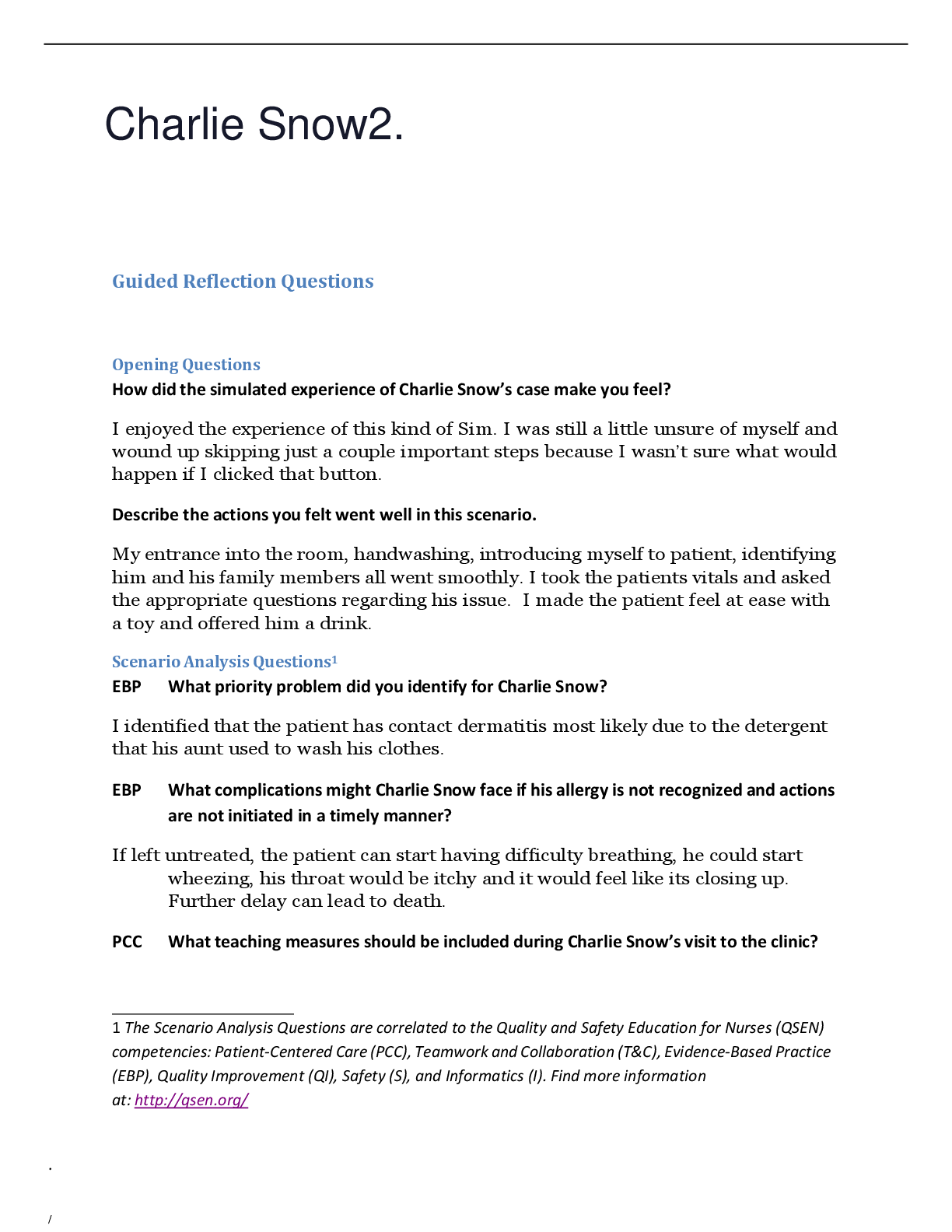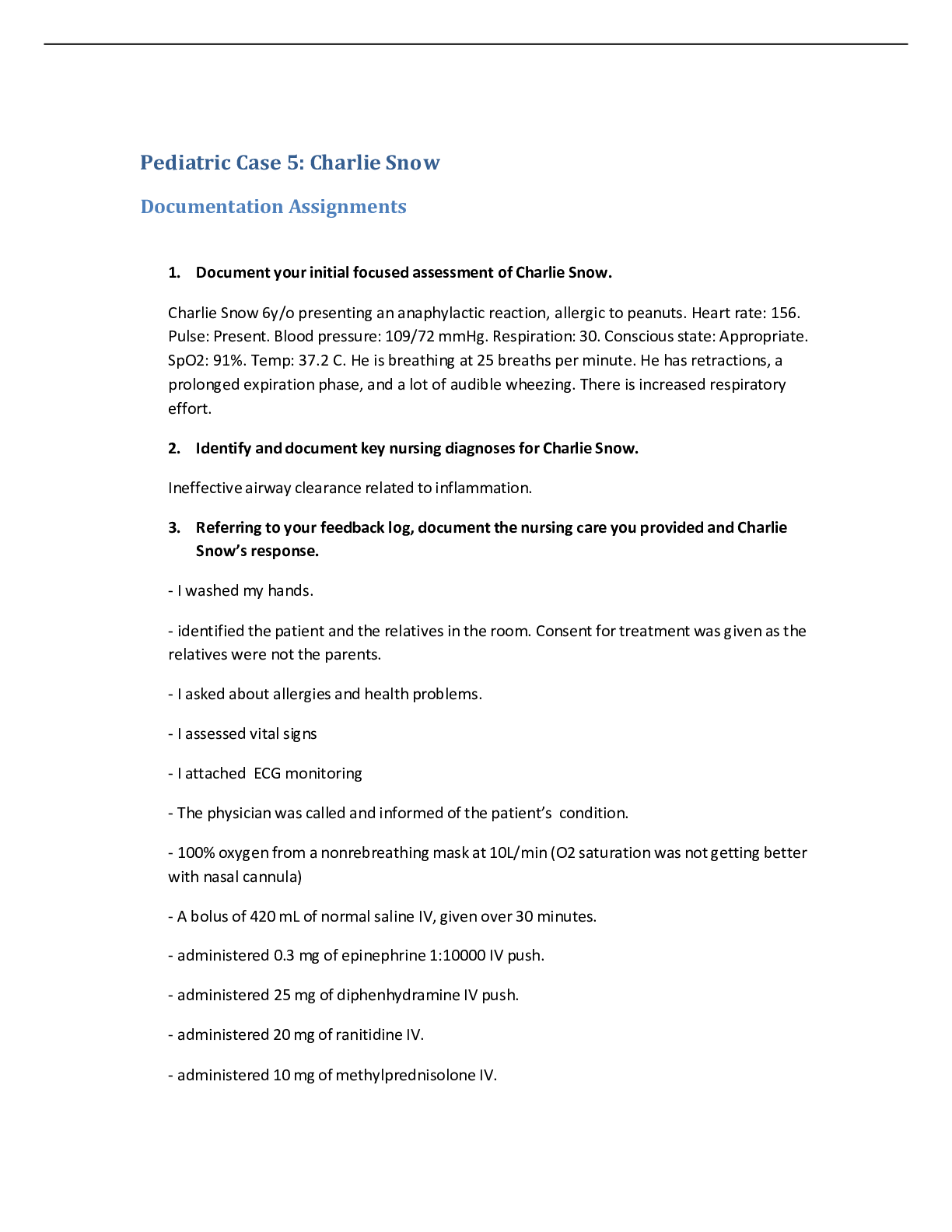Human Nutrition > EXAM > Unit 7 BTEC Health and Social Care Level 3 P1 M1 P2 P3 M2 D1 Sociological Perspectives for Health an (All)
Unit 7 BTEC Health and Social Care Level 3 P1 M1 P2 P3 M2 D1 Sociological Perspectives for Health and Social Care
Document Content and Description Below
Functionalism functionalism can be approached to sociology best by relating society to the human body as it functions through the power relation of major organs and has different but valuable insti... tutions in society which each have specific contributions to make. They use methods of social control together to deal with different members or groups, to establish that society operates very well without any complications. The development of functionalism in George Murdock's (1897-1985) perspective was that in all societies, the family had four functions: • The sexual function allowed for the expression of sexuality in an approved context. • The reproductive function provided stability for the rearing of children. • Socialisation included the responsibility of teaching children the acceptable ways of behaving in society. • The economic function meant that food, shelter and financial security had to be provided for the family members. Inequality is inevitable even desirable. Marxism Marxism is approached as being a conflict and also a structuralise model which was first developed by Karl Marx (1818-1883). Karl also thought that the individual behaviour was shaped by society, however he believed that the economic system defined society and people's roles within it. He observed that, the industrial society of his time there were two social classes: • Bourgeoisie- the tiny powerful group who owned the factories and all the other places of employment. • Proletariat- a much bigger, weak and unfortunate group of workers (the heavy- working people that the bourgeoisie employed). The conflict model of Marxism was viewed as two social class groups would always be in conflict: the bourgeoisie would have wanted high profits, and the proletariat would have wanted high wage. Which caused an unequal relationship between the two groups. The ruling class (bourgeoisie) also held power over other social industries and they shaped the society because they control most of the media and the legal system in the society. Unfortunately, through the socialisation process, it is the higher classes final decisions that are passed on, rather than the common value system of the functionalists. And with the proletariats lack of knowledge and awareness (false consciousness), the values and aims of the ruling classes are achieved. Feminism Feminists argued against the male dominance had produced unfair descriptions and analysis and that they did not pay much attention to the issues of the women and their unequal place in society. Advertisement of feminism is usually dated to 1792 and the publication of 'Mary Wollstonecraft's' vindication of the rights of women. The move for women to have vote had started in 1897 when Millicent Fawcett setup the National Union of women's suffrage societies. There were three main types of feminist approaches: This study source was downloaded by 100000803371112 from CourseHero.com on 07-12-2021 11:14:03 GMT -05:00 Marxist feminists believed that the capitalist system was responsible for the inequalities between men and women was society. Radical feminists believed that society was patriarchal with men overtaking the power over women and children; which may include violence. Some radical feminists believe that the solution was separatism. Liberal feminists believed that women and men were becoming more equal in society, but that more needed to be done through legislation and social progress to achieve equal opportunities. Interactionism Looking at individual interactions (small group rather than society as a whole group) as the main focus is on small groups and how they influence individual actions and shape of society. Integrationists may analyse groups as diverse as teenage groups, staff, patients and visitors in a health and social care setting. Interactionists believe that the individual's behaviour is compelled by the way we contribute in situations in small groups, how we see ourselves in other people's perspective in the group, what we think of other members and how they observe us. As being influenced by society, individuals use labels to make sense of the world and they tend to judge people's appearance with lack of communication being made with the person. Collectivism Collectivism had began so it could provide an equal basis through society work which helps health and social care services that is based by a government commitment to supply care and support for the unprotected, funded through taxation and National insurance. Since the passing of the Poor Law in 1601, the state had played a role in the care of the vulnerable in Britain. However, it wasn't until the nineteenth century that the governments took a significant role in supporting of the vulnerable. The Beveridge Report in 1942 provided the political foundation for a comprehensive range of welfare services; which some say that this did not happen until after the Second World War with the birth of 'Welfare State'. The collectivism was approached so that no one individual is more important than the other and all the work was accomplished with collective goals. Beveridge's five giant evils: • Sqaulor (poor housing) • Want (poverty) • Disease (ill-health) • Idleness (unemployment) • Ignorance (inadequate education) Postmodernism The approach to sociology, and the understanding of the rapid changes and the trouble in the society is based on postmodernism. Postmodernists would require that people should not talk about stable institutions like the family, religion, or the economic arrangements as none of these institutions stay the same. It is not possible to speak about the 'typical family' in the domestic arrangements as they are different to how people would define a typical family. Due to the regular changes in institutions and arrangements, postmodernists hold that structuralist perspectives like functionalism and Marxism no longer help people to understand the case of our society.The social institutions have been broken into pieces and This study source was downloaded by 100000803371112 from CourseHero.com on 07-12-2021 11:14:03 GMT -05:00 individuals and groups of people make their own decisions on institutions and their own lifestyle and do not follow the rules of the original institutions as they are confused about it. The New Right For many years the post-war collectivist approach remained largely the same for over many generations and was not seriously questioned or argued against it until the election of Margaret Thatcher's Conservative government in 1979, where the government was expecting the state to play a small role as possible in welfare arrangement. The government believed that welfare should be a huge responsibility in an individual's lifestyle and also their families. Whereas, The New Right believed state support as interfering and supporting a dependency culture. Mrs Thatcher and her government thought the welfare state created a society where they relied on state benefits and didn't put much effort in planning and working harder for their future and their family; families would trust and expect the state benefits to provide them with their needs and they would have not taken responsibility and look after their family without relying on anyone and people would have needed to work hard for their requirements. Assess the biomedical and socio-medical models of health Biomedical model: The biomedical model is a concept of health and illness, identifying health as ‘the absence of disease’. This concept concentrates on diagnosing and healing individuals with particular illnesses. The biomedical model developed in the mid-19th century as the primary model professionals would refer to in order to diagnose diseases and illnesses. The model does not include a diagnosis, which is resultant on the communication between medical professional and patient. This model states that health constitutes the independence from pain and disease, allowing the individual to be healthy. This model concentrates mostly on biological influences, excluding any social, environmental and psychological factors and is most common in western civilisations. The biomedical model of health is mostly dominant in western industrial societies such as the United Kingdom and United States of America. These civilisations believe that it is the personal responsibility of the individual to seek out medical help when ill. This is comparable to the functionalist ideals of the role of being ill. Functionalists also believe that ill-health can only be remedied by biomedical intervention. • Socio-medical model:The socio-medical model is a concept of health and illness concentrating on social and environmental factors manipulating health and well-being. This includes the effect of poverty, inadequate housing and pollution. It also focuses on what causes people to obtain poor health. This model is more concerned with public health and how it can be prevented in the individual. The socio-medical model of health study what the origin of an individual’s sickness is, whilst also researching society’s contribution on the individual becoming ill and what measures can be taken in order to prevent the illness from extending or reoccurring. P2 Explain different sociological approaches to health and ill health The functionalist approach: The functionalist approach to considering health and illness evolves from Talcott Pearson’s studies. Using the established functionalist approach he depicted that in order for society to operate comfortably, its associates must be healthy. Pearson depicted illness as a form of abnormality and ill members of society as fulfilling a form of social role. This became an influential concept in the sociology of illness. Pearson believed that if an individual announced their illness, specific rights and duties accompanied this role. Rights associated with the ill role were: • To be excused from typical social obligations such as school or work and from meeting typical family responsibilities. • To be cared for. Parsons believed that it was a key function of the family to care for ill and dependant individuals within the family circle. The responsibilities of the ill individual included: • Assuming all reasonable procedures in order to return to healthy status and resume with their typical place in society. Cooperating This study source was downloaded by 100000803371112 from CourseHero.com on 07-12-2021 11:14:03 GMT -05:00 with medical professionals. The functionalist belief (along with most governments) is that illness has social repercussions. Ill individuals are typically absent from work, and may require care, which must be efficiently dealt with in order for society to run conveniently. The Marxist approach: The Marxist approach speculates that the definitions of health and illness and health and social care services provided, benefit the interests of the dominant social classes. Doctors are viewed as forces significant modern study regarding the explanation for this difference are The Black Report (Townsend et al, 1980) accompanied by The Acheson Report (1998). These reports provide intricate and comprehensive interpretations of the connection between social and environmental components and health, illness and life expectancy. The findings of The Black Report discovered such extensive differences in the rates of health and illness between varied social classes that the current government during that time withheld its publication. A limited number of copies were produced, circulated and made available during August when it was assumed there would be very little media coverage. Regardless, this research has been exceptionally significant and the information provided is still commonly used by sociologists currently. The Black Report contemplated four forms of clarification that may account for the variety in levels of illness and life expectancy experienced by contrasting social classes. These analysts were convinced that the variety in health and well-being were affected by the rate of an individual’s income, the condition of their housing and environment in which the individual resided and worked. The four sociological explanations were: The statistical artefact explanation: The researchers working on The Black Report proposed that the variations could be due to the matter that the statistics themselves formed a biased impression. They debated that the individuals in the underlying social classes had a greater proportion of elderly individuals and individuals working in traditional and hazardous industries, so it would be predicted that these people would have greater levels of illness than the more fortunate individuals working in service industries such as call centres. This interpretation suggests that it is not particularly social class but age and structure and trends of employment of individuals in the underlying social groups that explain the variations. More recent studies, however, have established that even when researchers account for this bias in employment and age, they still discover a relationship between lesser social class and greater rates of illness and lower life expectancy. Natural or social selection: This interpretation proposes that it is not low social class and its combined low income, poverty and lower quality housing that cause illness, greater infant mortality rates and lower life expectancy for adult, it is the opposite way around. Individuals are in lower social classes due to their poor health, truancy and lethargy required for accomplishment. This interpretation has been refused by sociologists as there is evidence displaying the relationship between ill-health and deprived circumstances. Cultural or behavioural explanations: This interpretation concentrates on the behavioural and lifestyle choices of individuals in lower class groups. There was indication that individuals in lower class smoked more, consumed larger quantities of alcohol, more likely to ingest more junk foods and less likely to partake in sufficient physical activity. These poor lifestyle choices were associated with a variety of chronic illnesses such as heart disease, diabetes and some forms of cancer. It is a reality however, that these individuals in economically deprived situations use smoking and alcohol in order to endure these arduous circumstances. Material or structural explanations: Material interpretations declare that individuals involved in social groups with lower life expectancies and for whom infant mortality rates are significantly higher, experience poorer This study source was downloaded by 100000803371112 from CourseHero.com on 07-12-2021 11:14:03 GMT -05:00 health due to inequalities in life and earnings. Poverty and routinely low income are connected with poor diets, inadequate housing, unsatisfactory environments and more hazardous and uncertain employment. It is these inequalities and the connected destitution that contribute tothe variations in health and well-being. This study source was downloaded by 100000803371112 from CourseHero.com on 07-12-2021 11:14:03 GMT -05:00 Reference • Marilyn Billingham (2010). Sociological perspectives for health and social care. In: Beryl Stretch, Marilyn Billingham Health and Social Care, Btec National Level 3 Book 1. 301-320 • Class work [Show More]
Last updated: 2 years ago
Preview 1 out of 6 pages
.png)
Buy this document to get the full access instantly
Instant Download Access after purchase
Buy NowInstant download
We Accept:

Reviews( 0 )
$20.00
Can't find what you want? Try our AI powered Search
Document information
Connected school, study & course
About the document
Uploaded On
Jul 12, 2021
Number of pages
6
Written in
Additional information
This document has been written for:
Uploaded
Jul 12, 2021
Downloads
0
Views
112

















